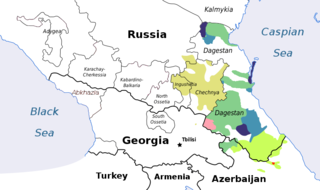
The Northeast Caucasian languages, also called East Caucasian, Nakh-Daghestani or Vainakh-Daghestani, or sometimes Caspian languages, is a family of languages spoken in the Russian republics of Dagestan, Chechnya and Ingushetia and in Northern Azerbaijan as well as in Georgia and diaspora populations in Western Europe and the Middle East. According to Glottolog, there are currently 36 Nakh-Dagestanian languages.
The history of Chechnya may refer to the history of the Chechens, of their land Chechnya, or of the land of Ichkeria.

The Caucasian languages comprise a large and extremely varied array of languages spoken by more than ten million people in and around the Caucasus Mountains, which lie between the Black Sea and the Caspian Sea.

The Chechens, historically also known as Kisti and Durdzuks, are a Northeast Caucasian ethnic group of the Nakh peoples native to the North Caucasus. They are the largest ethnic group in the region and refer to themselves as Nokhchiy. The vast majority of Chechens are Muslims and live in Chechnya, an autonomous republic within the Russian Federation.
Bats is the endangered language of the Bats people, a North Caucasian minority group. It is part of the Nakh family of Northeast Caucasian languages. It had 2,500 to 3,000 speakers in 1975.
Ingush, historically known as Durdzuks, Gligvi and Kists, are a Northeast Caucasian ethnic group mainly inhabiting Ingushetia in central Caucasus, but also inhabitanting Prigorodny District and town of Vladikavkaz of modern day North-Ossetia. The Ingush are predominantly Sunni Muslims and speak the Ingush language.

Tusheti is a historic region in northeast Georgia. A mountainous area, it is home to the Tusheti National Park.
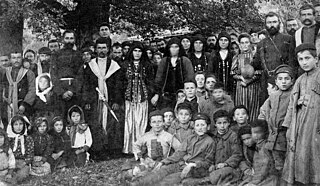
The Bats people or the Batsbi are Nakh-speaking Tushetians in the country of Georgia. They are also known as the Ts’ova-Tush (წოვათუშები) after the Ts’ova Gorge in the historic Georgian mountain region of Tusheti. The group should not be confused with the neighbouring Kists – also a Nakh-speaking people who live in the nearby Pankisi Gorge.
The Dvals were a ethnographic group of Georgians. Their lands lying on both sides of the central Greater Caucasus mountains, somewhere between the Darial and Mamison gorges. This historic territory mostly covers the north of Kartli, parts of the Racha and Khevi regions in Georgia and south of Ossetia in Russia.
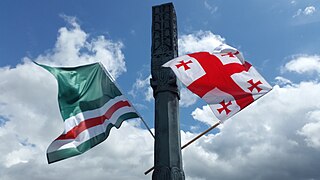
The Kists are a Chechen subethnic group in Georgia. They primarily live in the Pankisi Gorge, in the eastern Georgian region of Kakheti, where there are approximately 5,700 Kist people. The modern Kists are not to be confused with the historical term Kists, an ethnonym of Georgian origin, which was used to refer to the Nakh peoples in the Middle Ages.

The Nakh peoples are a group of North Caucasian peoples identified by their use of the Nakh languages and other cultural similarities. These are chiefly the ethnic Chechen, Ingush and Bats peoples of the North Caucasus, including closely related minor or historical groups.
The Vainakh languages are a dialect continuum that consists of the Chechen and Ingush languages, spoken mainly in the Russian republics of Chechnya and Ingushetia, as well as in the Chechen diaspora. Together with Bats, they form the Nakh branch of the Northeast Caucasian languages family.
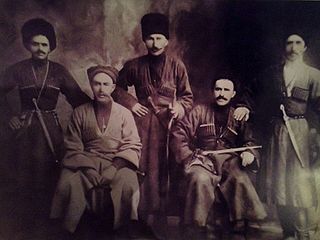
The Orstkhoy, historically commonly known under their exonyms: Karabulaks, Balsu, Baloy, are a historical ethnoterritorial society among the Chechen and Ingush peoples. Their homeland is in the upper reaches of the Assa and Fortanga rivers in the historical region of Orstkhoy-Mokhk. In the tradition of the Chechen ethno-hierarchy, it is considered one of the nine historical Chechen tukkhums, in the Ingush tradition as one of the seven historical Ingush shahars.
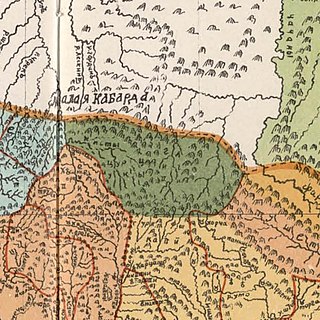
The Durdzuks, also known as Dzurdzuks, was a medieval exonym of the 9th-18th centuries used mainly in Georgian, Arabic, but also Armenian sources in reference to the Vainakh peoples.
Chamaecoetae were an ancient tribe mentioned by Greek geographer Strabo in his work Geographica during the first century AD. Some researchers connect them with the Ingush and localize them in mountainous Ingushetia, in Khamkhi, while others question these theories and argue that more arguments are needed.

Fappi or Fappi mokhk, exonym: Kistetia, is a historical region in Ingushetia. Fappi is the territory of historical settlement of the Fyappiy society.
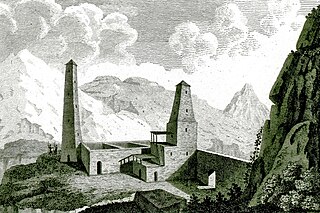
Ghalghai is the self-name (endonym) of the Ingush people.

Kists or Kistins is an old exonym of all Nakh peoples, under which local ingush societies later were designated, and conditionally divided into nearby Kistins (Fyappiy) and distant Kistins (Malkhistin). In Russian sources of the XVIII century the ethnonym «Kists» often referred exclusively to the Ingush people, and extended to all Nakh societies. In the of the 19th century, the term nearby Kistins referred to the inhabitants of the Kistin Gorge in the vicinity of river Armkhi, and distant Kistins referred to the inhabitants of the upper reaches of the Argun. Today the name is mostly used to refer to the Chechens who compactly live in the Pankisi Gorge of Georgia.

The Dzherakh, also spelled Jerakh, historically also known as Erokhan people, were a historical Ingush ethnoterritorial society, today a tribal organization/clan (teip), that was formed in the Dzheyrakhin gorge, as well as in the area of the lower reaches of the Armkhi River and the upper reaches of the Terek River.
Ethnonyms of the Ingush are names of Ingush people, including self-names (endonyms) and names used by other ethnic groups to refer to the Ingush (exonyms) throughout the existence of Ingush people from Middle Ages to the modern day.













